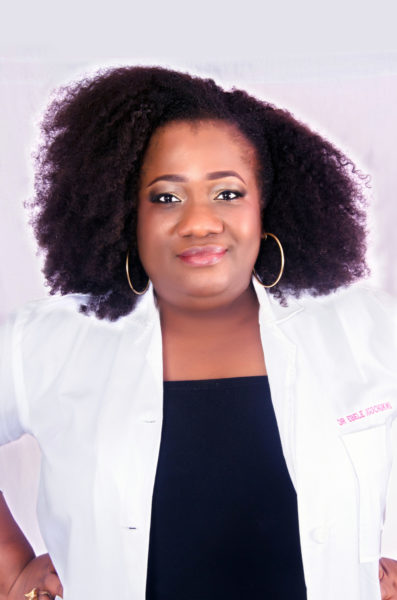Style
Co-Founder of Sleek Studio Dr. Ebele Ugochukwu says “Sunscreen is Not Just For White & Light Skinned People” | Read
 It is a popular belief that people with dark skin do not have to worry about sun exposure.
It is a popular belief that people with dark skin do not have to worry about sun exposure.
This is so not true.
Granted, the more melanin (the pigment responsible for the colour in our skin) the more you can withstand sun exposure.
The Fitzpatrick scale which classifies human skin pigmentation on a scale of 1 to 6 with 1 representing very pale skin that always burns and never tans with sun exposure to 6 being dark skin that never burns and tans easily.
According to the above scale, the ability to withstand sun exposure is referring to the fact that you do not burn – if you are dark skinned, due to protection from melanin. However, the damage caused by sunlight (ultraviolet rays) at the cellular level also affects people with dark skin; obviously not as severely as pale people but the damage does occur nonetheless.
This damage is the singular most important factor in the ageing process. People of colour do not age as obviously as those of Caucasian descent; the popular saying is true ‘black don’t crack’; so it is very possible to maintain the same skin you had in your thirties well into your sixties and beyond. The key is to protect yourself from the sun; in addition to other healthy practices of course, but the most important is limiting sun exposure.
So let’s talk about sunscreen.
In recent times, there has been an increase in awareness regarding the use of sunscreen but it is still largely confusing for most people.
Sunscreens can be broadly classified in to chemical absorbers and physical blockers. Chemical absorbers penetrate the skin and act by neutralizing the damaging sun rays (Ultra violet light; UVA/UVB); this class of sunscreen however can be irritating and allergy inducing, examples include Avobenzone, oxybenzone, para-aminobenozoic acid (PABA). Use of PABA has declined over the years due to the fact that it is highly irritating.
The second class are the physical blockers and these act as a barrier which the UVA/UVB bounce off of; they do not penetrate the skin hence it is usually not irritating or allergy inducing. However, they do tend to be thick, heavy and leave a whitish residue on the skin. Examples include Titanium dioxide, zinc oxide.
There are other chemical compounds used in sunscreen but as this is not a thesis, I will just leave it at the more common ones I have mentioned.
If you are label reader, (if you are not, I aim to make you one) you will come across titanium dioxide quite frequently.
Zinc oxide also is a very good broad spectrum sun screening agent.
Most cosmetic companies usually combine both chemical absorbers and physical blockers in their formulations in an attempt to minimise the adverse effects of the two groups.
The next thing you need to know about is SPF – which is Sun Protection Factor. This simply is a measure of how long it will take you to burn when out in the sun. If it takes you, say 30 minutes, for your skin to feel hot and sore under direct sun exposure, then the rationale is if you apply a product with an SPF of 15. It will take you 15×30 minutes to burn from sun exposure.
Obviously this is only a guide. Experts believe sunscreen should be reapplied every 2 hours irrespective of the SPF value. This of course is referring to those who actively sun bathe; even though we do not practise sun bathing often here in Nigeria, our sun exposure is intense.
People of colour absolutely need to use products with an SPF of at least 30 minutes before going out for their daily activities. This is still important even if you will not be in direct sunlight, the little bit that shines into your car on your way to work is enough to age you prematurely. Think of SPF as your pension plan for your skin, you may not see any real benefits now but trust me, you will be glad you did when you’re older.
The experts believe that SPF 30 is adequate. In fact, SPF of 100+ is a marketing gimmick; so also is all day water proof sunscreen. Sunscreen needs to be reapplied to remain effective.
For us women, reapplication of sunscreen when our faces are on fleek with makeup is a tall order; that is where SPF powders come in, regular touch ups with a an SPF powder should keep your face protected all day. Most Makeup companies are now making SPF powders.
The world leaders in SPF creams remains Neutrogena. They have an unparalleled formulation for effective yet light weight SPF lotions and creams that are easy to wear and comfortable even in our hot humid climate.
S-studio’s SPF 30 day cream is also light weight, mattifying and adequately moisturises the skin so you are getting much more than just a sunscreen.
When you know you will be in direct sunlight, other measures must be employed in addition to your SPF cream, these include; big sunglasses, wide brim hats and umbrellas.
Excessive sun exposure has been implicated in various forms of skin cancer, so this is not only about vanity, it’s also about your health.
Use your SPF daily and other protective measures for the times you will be under direct sunlight; your 70year old self will thank you.

























